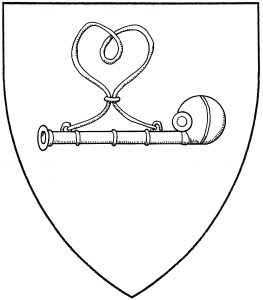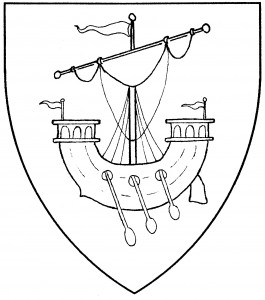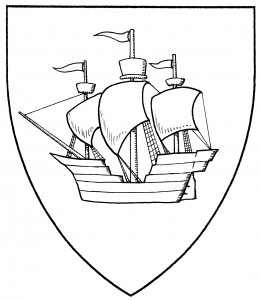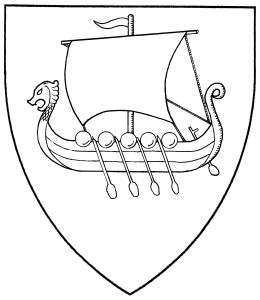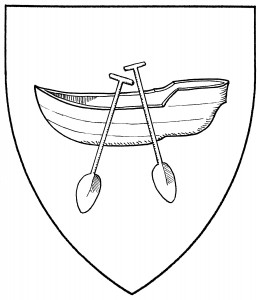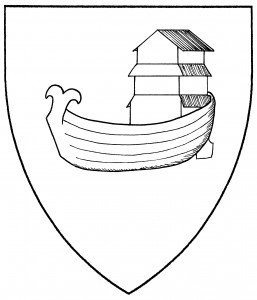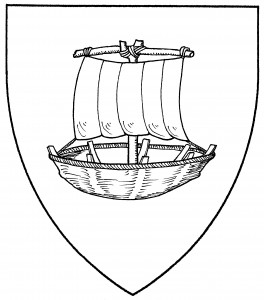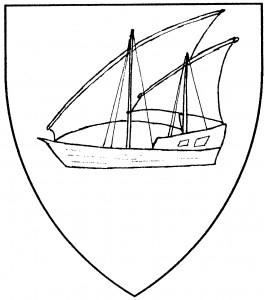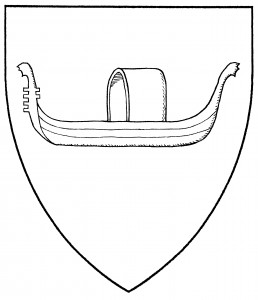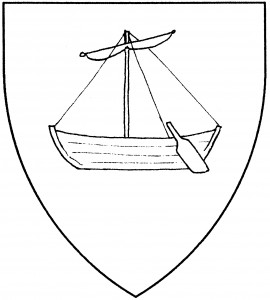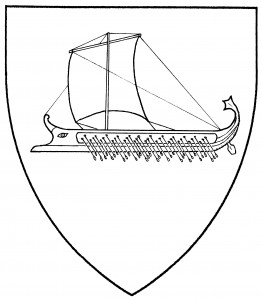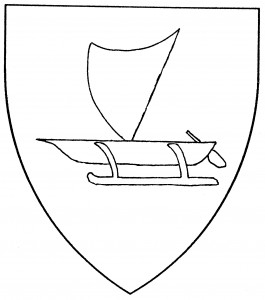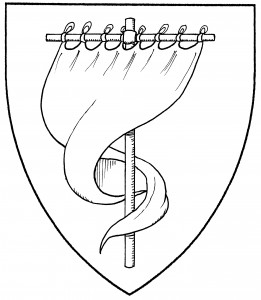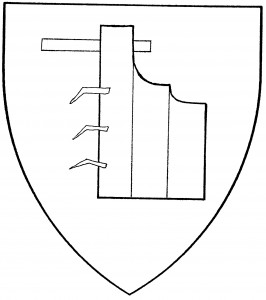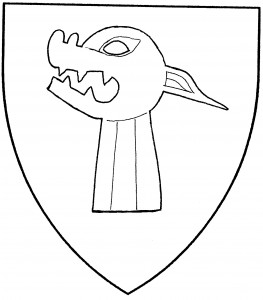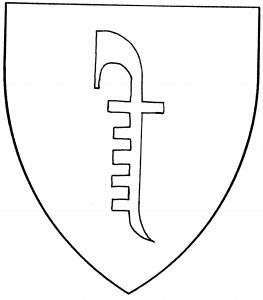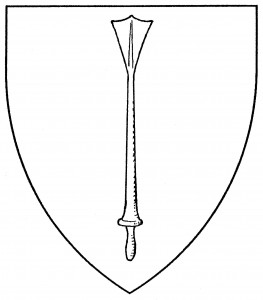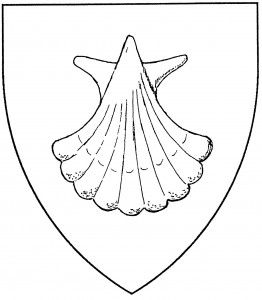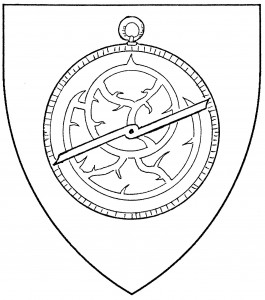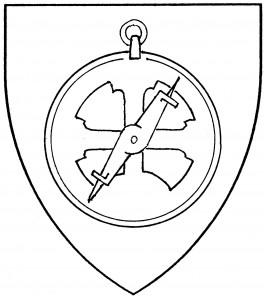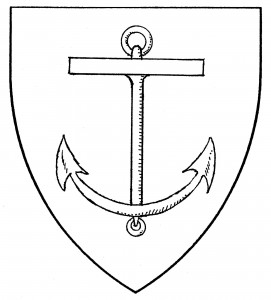Archives
Ship
A ship is a sailing vessel or boat; those found in heraldry usually have sails, though there are a few oar-powered ships as well. They should be drawn as seen on a calm sea: the keel should not be depicted. All ships face to dexter by default; when “proper”, they are of brown wood.
The most common sort of ship in heraldry is the “galley” or “lymphad”: a stylized drawing, with a single square sail, and three or four oars; the sails are furled, and the oars are in action, by default. It is a period charge, found in the arms of the Earls of Katenes (Caithness) c.1310 [ANA2 548]. When the sail is unfurled, the fact must be blazoned; when the oars are shipped (i.e., inside the ship and not visible), that too is sometimes blazoned. If the lymphad has no mast, sails or oars, it may be termed a “hulk” or “hull”, as in the arms of Segger, 1605 [Siebmacher 40].
Later in period, ships in heraldry began to be drawn as the ships then in use: with a bowsprit, multiple masts, and square sails, as in the illustration. Such ships may be seen in the crest of Sir Francis Drake, 1581, and the arms of the East India Merchants, 1600 [Woodcock & Robinson 84, 41]. These ships were blazoned simply as “ships” or “shippes”, and increasingly, they are so blazoned in the Society as well. Society armory also has examples of more specific types of late-period ships: e.g., the “caravel”, the “carrack”, and the “galleon”. These types of ships have been drawn with triangular (lateen) sails, in addition to the square sails; they have not always been accurately depicted. But in any case, they are indistinguishable for heraldic purposes.
In Society heraldry, the next most common ship is the “drakkar”, or Viking dragonship: with the prow carved in a monstrous head (usually a dragon’s), a square sail, and the ship’s side lined with targes. Ships decorated with dragon’s heads appear to have been used in period armory, in the arms of the Kings of Orkney, temp. Edward II [ANA2 548]. Matthew Paris, c.1245, attributes similar vessels to the arms of the King of Norway, as does Randall Holme’s Roll c.1460 [RH]; but we have no direct evidence that they were truly drakkars, or that the arms were actually in use. The drakkar is also blazoned a “Viking longship”; it’s not enough to say simply “longship”, as Norman and Phoenician longships are also found in Society armory.
The “rowboat” is a simpler craft, a shallow boat without mast, sails, or rudder, but with prominent oars surmounting it. The oars may be drawn as held in oarlocks; their number should be specified in the blazon. The rowboat is a period charge, found as early as c.1340, in the arms of Oberreiden [Zurich 284].
Of the other, more unusual ships in Society heraldry, there is found the “ark”, a mastless vessel with a barn-like shape amidships, as seen in the crest of the Mistery of Shipwrights of England, 1606 [Bromley & Child 221]; the “coracle” or “curragh”, a small round boat made from hides stretched over a wicker frame; the “dhow”, a small Oriental ship with a triangular sail; the “gondola”, the famous traffic boat of Venice, here taken from the album amicorum (autograph book) of Gerard van Hacfort and Poppe van Feytsma, c.1570; the “knorr”, a small single-sailed boat with its rudder on the side; the “trireme”, an ancient warship named for its three rows of oars; and the “wa’a”, a Polynesian outrigger canoe with a single sail.
The Baron of the Western Seas bears: Or, a wa’a outrigger, sail to dexter sable, within a laurel wreath vert within a bordure engrailed azure.
Lüthard von Calebergh bears: Azure, three lymphads, oars shipped, argent.
Bjornulf of Thorshafn bears: Argent, a knorr proper, sails furled vert, within a bordure azure.
Medraut Beorhtwig bears: Ermine, three drakkars in pale gules.
Royce Kensington bears: Sable, three carracks and a bordure embattled argent.
Ciaran Cluana Ferta bears: Or, a curragh proper sailed and tillered gules, in chief two Celtic crosses sable.
Burrell de Gillson bears: Azure, in chief two dolphins embowed and in base a hulk dismasted all Or.
Alexandria de Bois d’Arc bears: Purpure, an ark and a chief invected argent.
Maurice de Granada bears: Or, a dhow, sail set and sinister facing vert within a bordure vert bezanty.
Asa of the Wood bears as a badge: Azure, a gondola Or within an orle of plates.
Thomas Wright of Lancaster bears: Argent, in bend three triremes reversed azure and a chief wavy azure semy-de-lys argent.
Walborg Liucoin bears: Sable, a seven-oared rowboat, in base a bar wavy and on a chief Or three mullets sable.
Sail
A sail is a broad sheet of canvas, used by ships for catching the wind and pushing forward. It’s a period charge, found in the canting arms (Italian vela) of da Velate, mid-15h C. [Triv 366]. The form shown in period arms is triangular (cf. also Guillim1 215); and this is the only permitted form for Society armory, pending documentation.
See also flag.
The King of Trimaris bears as a badge: A sail fastened to its mast and hanging from its yardarm azure.
Morgan Grey Beard bears: Argent, a sail vert fastened to its mast and hanging from its yardarm sable.
Rudder
A rudder is a broad, flat piece of wood, attached to the stern of a ship and used to steer it. It’s a period charge, used as a badge by Willoughby, Lord Broke, c.1520 [HCE xxxiv]. The rudder has its hinge to dexter by default; it is usually, though not invariably, shown with its tiller.
Maria Corva bears: Quarterly azure and vert, a rudder Or.
Raymond Carder the Sea Rover bears as a badge: On a rudder purpure, an equal-armed Celtic cross saltirewise Or.
Prow
A prow is the bow or front of a ship. As artifacts, medieval prows were frequently ornate, made of carved wood; they don’t seem to have been used in period heraldry. In Society heraldry, the most common prow is the “drakkar prow”, the figurehead of a Viking longship; this charge is sometimes blazoned as a “dragon’s head couped”, from which it is negligibly different. Though we have period examples of Norse ships with beast’s heads as prows – e.g., the Norse ship on the town seal of Bergen, c.1300 [Gwyn Jones, A History of the Vikings, 1984, p.227], from which the illustration is taken – the lack of standardization makes the drakkar prow no longer registerable, barring evidence.
There is also the “gondola prow”, the traditional carved bow of the gondolas of Venice. Both sorts of prow are couped and face dexter (as would their ships), by default. For related charges, see head (monster).
Thorfinn Rognvald Hundr bears: Per pale argent and sable, in fess two drakkar prows addorsed counterchanged.
Marina Foscari bears: Quarterly sable and gules, a cross between in bend two gondola prows reversed, all within a bordure argent.
Oar
An oar is a long pole with a broad blade at one end, used for rowing a boat. Its default orientation is palewise, blade to chief; its “proper” coloration is brown, the color of wood. The illustration is taken from the arms of the Worshipful Company of Watermen and Lightermen, granted in 1585 [Bromley & Child 256].
The oar is also often found in the company of a ship, which is then blazoned “with its oars in action”; in that case, the oars have their blades to base (i.e., in the water). See also peel (baker’s).
Adriana Tacita bears: Per pale purpure and Or, two oars counterchanged.
Finnvarðr mjoksiglandi Grísson bears: Per fess rayonny gules and azure, in chief two oars in saltire argent.
Cato ap Brion bears: Vert, an oar fesswise Or.
Escallop
An escallop is the shell of a bivalve mollusc; it is also called a “scallop”, “cockle” or “cockleshell”. The escallop is an ancient charge, found in the arms of Dacre c.1282 [ANA2 351]; it was used as a pilgrim’s badge in medieval times, as it was the symbol of St. James, patron of pilgrims. The escallop has its hinge to chief by default.
Karl von Kugler bears: Checky Or and sable, an escallop azure.
Nuala inghean Murchadha bears: Vert, six escallops Or.
Llywelyn ap Evan bears: Per fess azure and vair ancient, three escallops in chief argent.
Astrolabe
An astrolabe is an astronomical instrument; it was used for surveying the positions of the stars and planets, and calculating sidereal time. The device is period – Chaucer wrote a “Treatise on the Astrolabe” c.1391, in which he translated earlier Moslem texts – but no examples of it have been found in period armory. In Society heraldry, the astronomer’s astrolabe is granted no difference from a roundel.
A simplified form of astrolabe, the “mariner’s astrolabe”, was used for navigation; it’s distinguished by large holes in the plate, so the wind wouldn’t interfere with surveying. While it too was a period artifact, dating from Portugal c.1480, no armorial examples have been found.
See also clock, equatorium, quadrant, sphere, sundial.
David MacColin bears: Per chevron throughout sable and argent, two open penannular brooches palewise, pins to base, and an astrolabe counterchanged.
Duncan Ramsay bears: Quarterly gules and vert, an astrolabe within an orle wavy Or.
Vincent McThomas bears: Argent, a mariner’s astrolabe azure and a ford proper.
Anchor
An anchor is a weighted hook that moors a ship. It’s frequently found in period armory, as in the arms of Skipton, c.1410 [TJ 1507].
Heraldry has special terms for some parts of an anchor: the shank (upright) is blazoned the “beam”, the stock (crosspiece) is the “timber”. The timber is to chief by default, but anchors inverted were not uncommon in period heraldry. An “anchor fouled of its cable” has its cable wrapped around the beam.
There were some variation in the heraldic depiction of the anchor; the illustration is taken from de Bara’s Blason des Armoiries, 1581 [64]. For related charges, see grappling iron.
Molle of Norwiche bears: Sable, three anchors argent.
John of the Rudder bears: Gules, an anchor Or.
Aethelstan Osricson bears: Or, three anchors in pall, rings to center vert.
